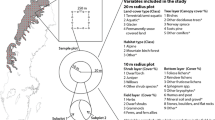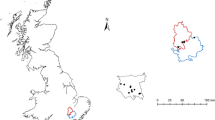Abstract
Practical and useful vegetation monitoring methods are needed, and data compatibility and validation of remotely sensed data are desirable. Methods have not been adequately tested for heathy woodlands. We tested the feasibility of detecting species composition shifts in remnant woodland in South Australia, comparing historical (1986) plot data with temporal replicates (2010). We compared the uniformity of species composition among spatially scattered versus spatially clustered plots. At two sites, we compared visual and point-intercept estimation of cover and species diversity. Species composition (presence/absence) shifted between 1986 and 2010. Species that significantly shifted in frequency had low cover. Observations of decreasing species were consistent with predictions from temperature response curves (generalised additive models) for climate change over the period. However, long-term trends could not be distinguished from medium-term dynamics or short-term changes in visibility from this dataset. Difficulties were highlighted in assessing compositional change using historical baselines established for a different purpose in terms of spatial sampling and accuracy of replicate plots, differences in standard plot methods and verification of species identifications. Spatially clustered replicate plots were more similar in species composition than spatially scattered plots, improving change detection potential but decreasing area of inference. Visual surveys detected more species than point-intercepts. Visual cover estimates differed little from point-intercepts although underestimating cover in some instances relative to intercepts. Point-intercepts provide more precise cover estimates of dominant species but took longer and were difficult in steep, heathy terrain. A decision tree based on costs and benefits is presented assessing monitoring options based on data presented. The appropriate method is a function of available resources, the need for precise cover estimates versus adequate species detection, replication and practical considerations such as access and terrain.








Similar content being viewed by others
References
Abbott, I., & Le Maitre, D. (2010). Monitoring the impact of climate change on biodiversity: the challenge of megadiverse Mediterranean climate ecosystems. Austral Ecology, 35, 406–422.
Anderson, M. J. (2001). A new method for non-parametric multivariate analysis of variance. Austral Ecology, 26, 32–46.
Armstrong, D.M., Croft, S.J. & Foulkes, J.N. (2003) A Biological Survey of the Southern Mount Lofty Ranges, South Australia, 2000–2001. (Department for Environment and Heritage, South Australia).
Bardsley, D. K., & Sweeney, S. M. (2010). Guiding climate change adaptation within vulnerable natural resource management systems. Environmental Management, 45, 1127–1141.
Barry, S., & Elith, J. E. (2006). REVIEW: error and uncertainty in habitat models. Journal of Applied Ecology, 43, 413–423.
Bishop, C. L., Wardell-Johnson, G. W., & Williams, M. R. (2010). Community-level changes in Banksia woodland following plant pathogen invasion in the Southwest Australian Floristic Region. Journal of Vegetation Science, 21, 888–898.
Bouxin, G. (2005). Ginkgo, a multivariate analysis package. Journal of Vegetation Science, 16, 355–359.
Buckman, S., Brownlie, K. C., Bourman, R. P., Murray-Wallace, C. V., Morris, R. H., Lachlan, T. J., Roberts, R. G., Arnold, L. J., & Cann, J. H. (2009). Holocene palaeofire records in a high-level, proximal valley-fill (Wilson Bog), Mount Lofty Ranges, South Australia. The Holocene, 19(7), 1017–1029.
Carlsson, A. L. M., Bergfur, J., & Milberg, P. (2005). Comparison of data from two vegetation monitoring methods in semi-natural grasslands. Environmental Monitoring and Assessment, 100, 235–248.
Chen, J., Shiyomia, M., Horia, Y., & Yamamura, Y. (2008). Frequency distribution models for spatial patterns of vegetation abundance. Ecological Modelling, 211, 403–410.
Colwell, R.K. (2009) EstimateS: statistical estimation of species richness and shared species from samples. Version 8.2. User's guide and application published at: http://purl.oclc.org/estimates.
Colwell, R. K., & Coddington, J. A. (1994). Estimating terrestrial biodiversity through extrapolation. Philosophical Transactions of the Royal Society, London B, 345, 101–118.
Crisp, M. D., Laffan, S., Linder, H. P., & Monro, A. (2001). Endemism in the Australian flora. Journal of Biogeography, 28, 183–198.
De Caceres, M., Oliva, F., Font, X., & Vives, S. (2007). Ginkgo, a program for non-standard multivariate fuzzy analysis. Advances in Fuzzy Sets and Systems, 2, 41–56.
Department of Housing & Urban Development (1997) Guide to a native vegetation survey: using the biological survey of South Australia. Geographic Analysis and Research Unit, Information and Data Analysis Branch, Department of Housing & Urban Development; edited by Leonie Heard and Bronwen Channon.
R Development Core Team (2010) R: a language and environment for statistical computing. R Foundation for Statistical Computing, Vienna, Austria. ISBN 3-900051-07-0, URL http://www.R-project.org.
Fiala, A. C. S., Garman, S. L., & Gray, A. N. (2006). Comparison of five canopy cover estimation techniques in the western Oregon Cascades. Forest Ecology and Management, 232, 188–197.
Godínez-Alvarez, H., Herrick, J. E., Mattocks, M., Toledo, D., & Van Zee, J. (2009). Comparison of three vegetation monitoring methods: their relative utility for ecological assessment and monitoring. Ecological Indicators, 9, 1001–1008.
Goslee, S. C., & Urban, D. L. (2007). The ecodist package for dissimilarity-based analysis of ecological data. Journal of Statistical Software, 22(7), 1–19.
Hastie, T. (2011). gam: generalized additive models. R package version 1.04. http://CRAN.R-project.org/package=gam
Hijmans, R. J., Cameron, S. E., Parra, J. L., Jones, P. G., & Jarvis, A. (2005a). Very high resolution interpolated climate surface for global land areas. International Journal of Climatology, 25, 1965–1978.
Hijmans, R. J., Guarino, L., Jarvis, A., O’Brien, R., Mathur, P., Cruz, C. B. M., Barrantes, I. & Rojas, E. (2005b) DIVA-GIS, version 5. Manual. Available at http://www.diva-gis.org/
Jurasinski, G. & Retzer, V. (2010) simba: a collection of functions for similarity analysis of vegetation data. R package version 0.3-2. http://CRAN.R-project.org/package=simba
Lawson, D. M., Regan, H. M., Zedler, P. H., & Franklin, J. (2010). Cumulative effects of land use, altered fire regime and climate change on persistence of Ceanothus verrucosus, a rare, fire-dependent plant species. Global Change Biology, 16, 2518–2529.
Legg, C. J., & Nagy, L. (2006). Why most conservation monitoring is, but need not be, a waste of time. Journal of Environmental Management, 78, 194–199.
Oksanen, J., Blanchet, F.G., Kindt, R., Legendre, P., O'Hara, R.B., Simpson, G.L., Solymos, P., Henry, M., Stevens, H. & Wagner, H. (2011) Vegan: community ecology package. R package version 1.17-6. http://CRAN.R-project.org/package=vegan
Philippi, T. E., Dixon, P. M., & Taylor, B. E. (1998). Detecting trends in species composition. Ecological Applications, 8(2), 300–308.
Preiss, W. V. (2000). The Adelaide Geosyncline of South Australia and its significance in Neoproterozoic continental reconstruction. Precambrian Research, 100, 21–63.
Ramesh, B. R., Venugopal, P. D., Pélissier, R., Patil, S. V., Swaminath, M. J., & Couteron, P. (2010). Mesoscale patterns in the floristic composition of forests in the Central Western Ghats of Karnataka, India. Biotropica, 42(4), 435–443.
Reinke, K., & Jones, S. (2006). Integrating vegetation field surveys with remotely sensed data. Ecological Management & Restoration, 7(s1), S18–S23.
Ruokolainen, L., & Salo, K. (2009). The effect of fire intensity on vegetation succession on a sub-xeric heath during ten years after wildfire. Annales Botanici Fennici, 46, 30–42.
Sang, W., & Bai, F. (2009). Vascular diversity patterns of forest ecosystem before and after a 43-year interval under changing climate conditions in the Changbaishan Nature Reserve, northeastern China. Plant Ecology, 201, 115–130.
Schipper, A. M., Lotterman, K., Leuven, R. S. E. W., Ragas, A. M. J., de Kroon, H., & Hendriks, A. J. (2011). Plant communities in relation to flooding and soil contamination in a lowland Rhine River floodplain. Environmental Pollution, 159, 182–189.
Suppiah, R., Preston, B., Whetton, P.H., McInnes, K.L., Jones, R.N., Macadam, I., Bathols, J. & Kirono, D. (2006) Climate change under enhanced greenhouse conditions in South Australia. An updated report on: Assessment of climate change, impacts and risk management strategies relevant to South Australia. Climate Impacts and Risk Group, CSIRO Marine and Atmospheric Research. June 2006. http://www.climatechange.sa.gov.au/uploads/pdf/SA_CMAR_report_High_resolution.pdf
Vittoz, P., & Guisan, A. (2007). How reliable is the monitoring of permanent vegetation plots? A test with multiple observers. Journal of Vegetation Science, 18, 413–422.
Vos, P., Meelis, E., & Ter Keurs, W. J. (2000). A framework for the design of ecological monitoring programs as a tool for environmental and nature management. Environmental Monitoring and Assessment, 61, 317–344.
Zhou, Q., Robson, M., & Pilesjoè, P. (1998). On the ground estimation of vegetation cover in Australian rangelands. International Journal of Remote Sensing, 19(9), 1815–1820.
Acknowledgments
We thank the South Australian Premier's Science and Research Fund, Terrestrial Ecosystems Research Network, the Australian Research Council (LP110100721) and SA Department of Environment, Water and Natural Resources. We also thank Sonia Croft, Robert Colwell, Ben Sparrow, Andrew White, Jeff Foulkes, Duncan Jardine, Haixia Wen and David Keith.
Author information
Authors and Affiliations
Corresponding author
Electronic supplementary material
Below is the link to the electronic supplementary material.
ESM 1
(DOC 259 kb)
Rights and permissions
About this article
Cite this article
Guerin, G.R., Lowe, A.J. Systematic monitoring of heathy woodlands in a Mediterranean climate—a practical assessment of methods. Environ Monit Assess 185, 3959–3975 (2013). https://doi.org/10.1007/s10661-012-2842-3
Received:
Accepted:
Published:
Issue Date:
DOI: https://doi.org/10.1007/s10661-012-2842-3




